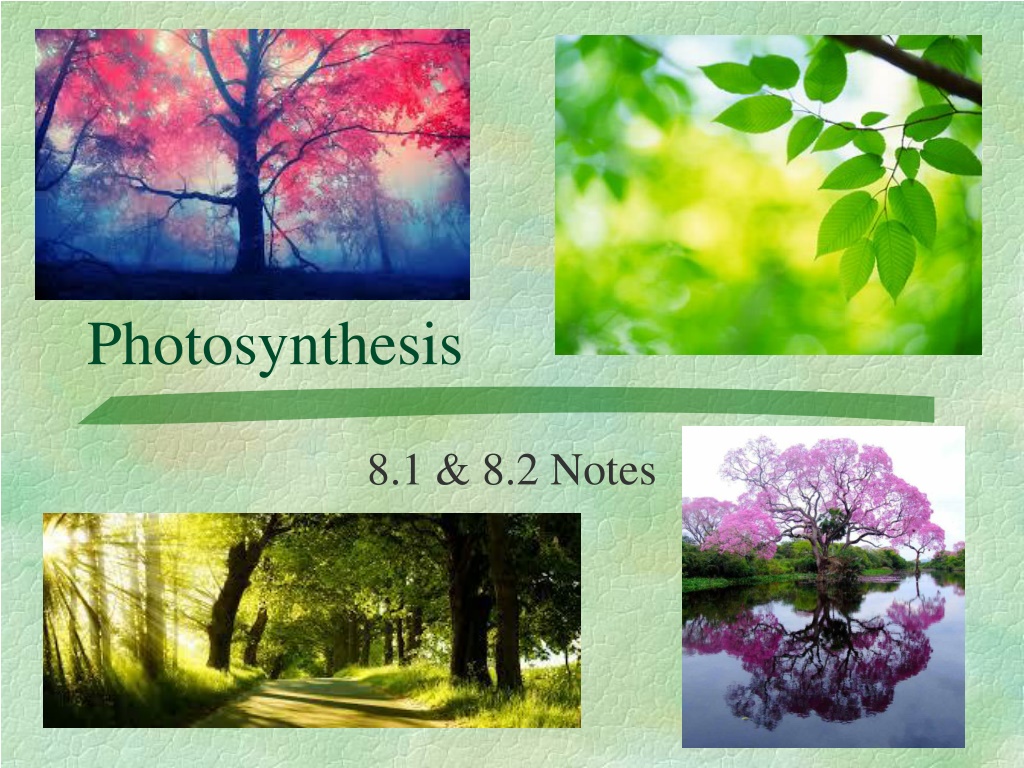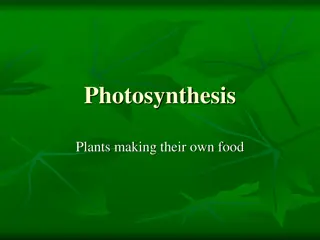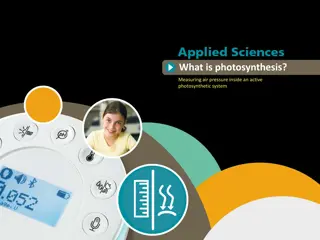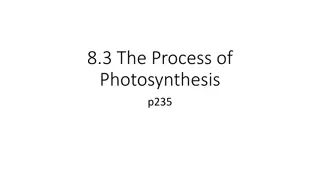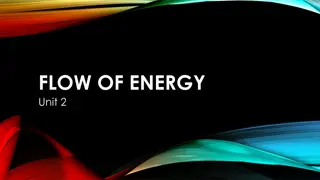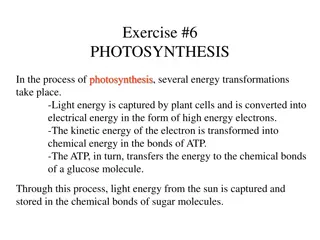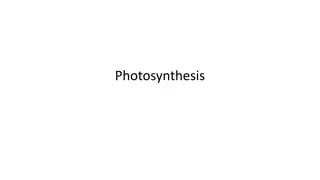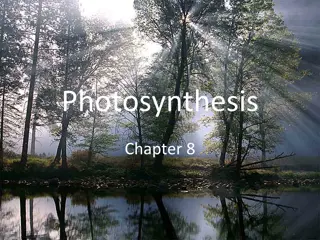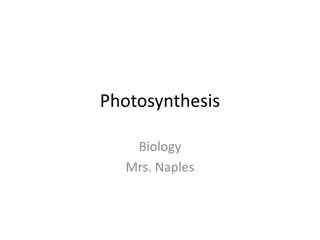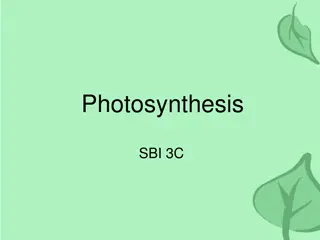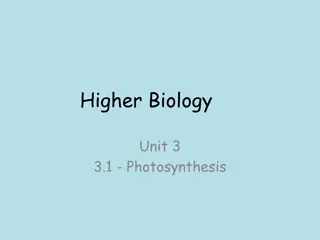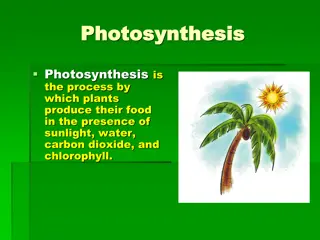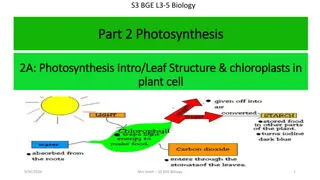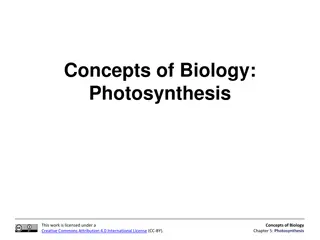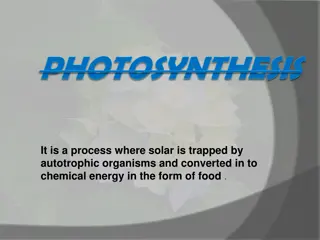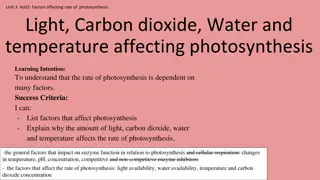Understanding Photosynthesis: Energy Conversion in Plants
Photosynthesis is a vital process where plants convert sunlight, carbon dioxide, and water into glucose and oxygen. This energy conversion is crucial for sustaining life on Earth, as it provides food for organisms and releases oxygen into the atmosphere. The process involves the utilization of chemical energy in the form of ATP and the transformation of inorganic materials into organic molecules. Heterotrophs and autotrophs play key roles in the ecosystem, with plants serving as primary producers through photosynthesis. This process initiates food chains and supports all life forms by generating essential nutrients and oxygen. Explore the significance and mechanisms of photosynthesis to appreciate its impact on the environment and living organisms.
Download Presentation

Please find below an Image/Link to download the presentation.
The content on the website is provided AS IS for your information and personal use only. It may not be sold, licensed, or shared on other websites without obtaining consent from the author. Download presentation by click this link. If you encounter any issues during the download, it is possible that the publisher has removed the file from their server.
E N D
Presentation Transcript
Photosynthesis 8.1 & 8.2 Notes
Chemical Energy and ATP Energy is the ability to do work. Your cells are busy using energy to build new molecules, contract muscles, and carry out active transport. Without the ability to obtain and use energy, life would cease to exist.
Chemical Energy and ATP One of the most important compounds that cells use to store and release energy is ATP (adenosine triphosphate ). ATP consists of adenine, a 5-carbon sugar called ribose, and three phosphate groups.
Storing Energy Adenosine diphosphate (ADP) has two phosphate groups instead of three. ADP contains some energy, but not as much as ATP..
Heterotrophs and Autotrophs Organisms that obtain food by consuming other living things are known as heterotrophs. Organisms that make their own food are called autotrophs (Plants, algae, and some bacteria) Photosynthesis- use the energy of sunlight to produce high-energy carbohydrates
Why is Photosynthesis important? Makes organic molecules (glucose) out of inorganic materials (carbon dioxide and water). It begins all food chains/webs. Thus all life is supported by this process. It also makes oxygen gas!!
Photo-synthesis means "putting together with light." Plants use sunlight to turn water and carbon dioxide into glucose. Glucose is a kind of sugar. Plants use glucose as food for energy and as a building block for growing. Autotrophs make glucose and heterotrophs are consumers of it. BD13730_
greenplants Photosynthesis sunlight Carbon dioxide + water glucose + oxygen absorbed by chlorophyll 6CO2 + 6H2O + energy C6H12O6 + 6O2 As can be seen from the equation for photosynthesis, the wood, bark, and root came from water and carbon dioxide.
Visible light is only a small part of the electromagnetic spectrum (all forms of light).
Pigments Plants gather the sun s energy with light- absorbing molecules called pigments. The plants principal pigment is chlorophyll.
Pigments Leaves reflect green light, which is why plants look green. Plants also contain red and orange pigments such as carotene that absorb light in other regions of the spectrum.
Chloroplasts Photosynthesis takes place inside organelles called chloroplasts. Chloroplasts contain saclike photosynthetic membranes called thylakoids
Chloroplasts Pigments are located in the thylakoid membranes. The fluid portion outside of the thylakoids is known as the stroma.
Stomata This opening how plants exchange gases! Check it! Can you name the two important gases that go in and out of the leaves? -CO2 -O2
Light-Dependent Reactions The light-dependent reactions use energy from sunlight to produce energy (ATP and NADPH.) These reactions take place within the thylakoid membranes of the chloroplast.
Light-Independent Reactions No light is required to power the light-independent reactions. The light-independent reactions take place outside the thylakoids, in the stroma.
What is the main compound used for energy? ATP (Adenosine Triphosphate)
What is the general formula for photosynthesis? Water + CO2 + Sunlight - Glucose + O2 6CO2 + 6H2O + energy 6O2 C6H12O6 +
What two reactions make up photosynthesis? Light-dependent reactions Light-independent reactions
